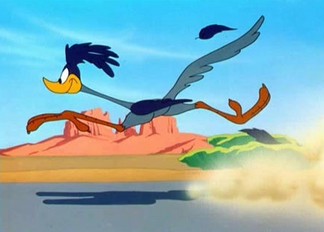Roadrunners are neotropical invaders that spread across North America, probably no earlier than the late Pleistocene. Fossil remains of roadrunners dating to this time period have been excavated from sites in Arizona, New Mexico, and California. Roadrunners are ground foraging birds in the cuckoo (Cuculidae) family. All other members of this family prefer the tree canopy. There are just 2 species of roadrunner–Geococcyx californianus ranges from central Mexico west to California and east to Arkansas and Louisiana and G. velox occurs in tropical deciduous forests from southern Mexico to Nicaragua. The ancestor of these species likely diverged during an arid climate cycle of the Pleistocene. G. californianus evolved a preference for desert scrub and cactus environments and moved north across the Rio Grande. I think they are a fairly recent colonizer of this region because desert grassland and scrub habitat was widespread across southeastern North America during the late Pliocene/early Pleistocene about 2 million years ago, yet there is no fossil evidence of roadrunners in this region from that time period. If roadrunners lived in southwestern North America during this early time period when their ideal habitat was so widespread, I believe they would have colonized the southeast. And they would still persist in some areas of the southeast where favorable habitat exists. There’s no shortage of thickets mixed with clearings in the southeast. In Arkansas, the easternmost part of their modern range, roadrunners occur in farms and clearings, cedar glades, scrubby woods, and rocky outcroppings. Currently, the Mississippi river appears to be a barrier that prevents them from expanding their range east. They haven’t crossed the river yet because they are weak flyers and prefer to run in zigzag patterns between thickets. They are the fastest runners among birds capable of flight, reaching speeds of 25 mph–about the speed of an Olympic male sprinter.

Roadrunner killing snake. They kill their prey by bashing it against the ground until it is senseless.
Roadrunner range map. I believe the Mississippi River is the barrier that keeps them from expanding their range east.
Video of a roadrunner ambushing an hummingbird at a feeder.

Real life roadrunners are smart like their cartoon imitation.
Pleistocene roadrunners were slightly larger than modern roadrunners but are considered to be the same species. Scientists believe they grew to a larger size due to cooler Ice Age summers. The modern smaller birds have more endurance in warmer conditions than larger birds and can chase down their favored prey (lizards, snakes, mice, scorpions, insects, and other birds) for longer periods.
Roadrunners are poorly studied. I searched The Auk and The Condor, 2 ornithology journals, for more information about them and found very few articles.. They are an intelligent bird, not unlike their cartoon counterpart, and this makes them hard to study because they are smart enough to avoid traps. This is 1 case when the cartoon imitation of an animal matches its real personality.
Tags: a late Pleistocene colonizer, Geococcyx californianus, roadrunner

August 6, 2016 at 3:55 pm |
I met my roadrunner on top of the Petroglyph National Monument at Albuquerque
July 6, 2020 at 1:34 pm |
[…] wrote an article a few years ago about roadrunners (Geococcyx californiannus). (See: https://markgelbart.wordpress.com/2016/08/05/pleistocene-roadrunners-geococcyx-californianus/ ) I noticed roadrunners ranged into Arkansas–a curious eastern range extension–and I […]